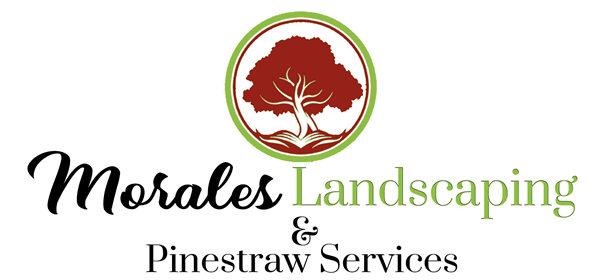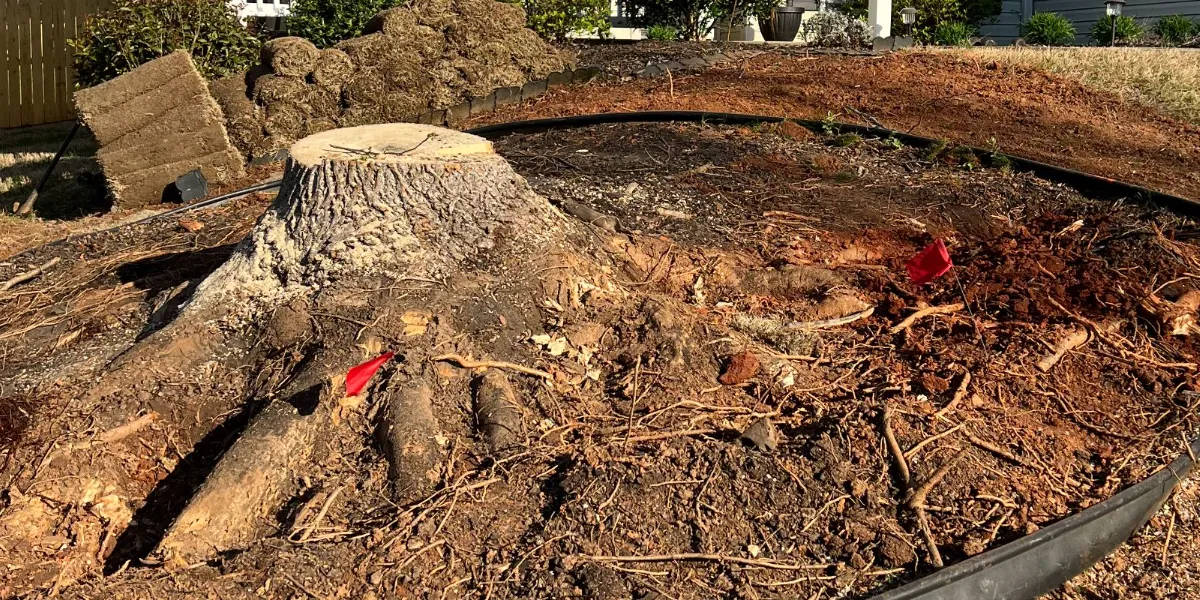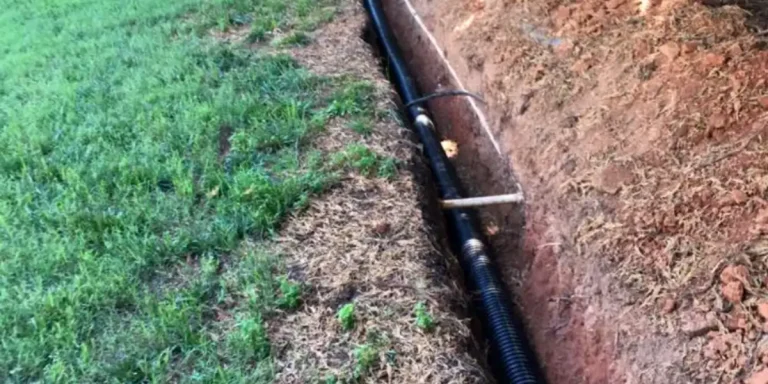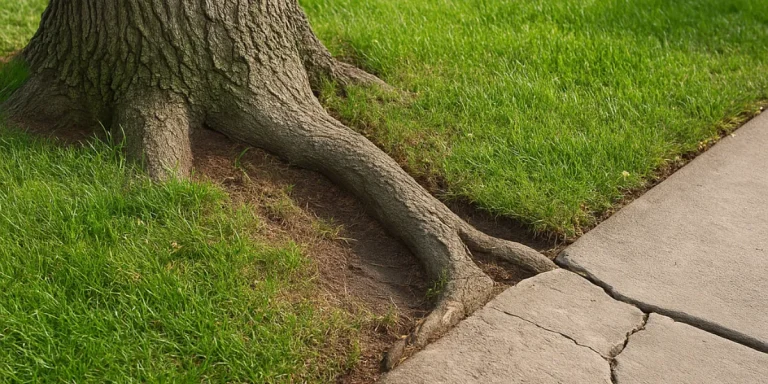Signs a Tree on Your Property Needs to Be Removed
Trees are a valuable part of any landscape, but not every tree is meant to stay forever. Sometimes, a tree can pose a serious risk to your home, your safety, or your property’s health. If you’re unsure whether a tree on your property in Greenville, SC or the surrounding area needs to be removed, there are some warning signs to watch for.
Understanding these signs early can help prevent expensive damage and give you peace of mind. In this post, we’ll walk you through the most common indicators that it’s time to call a professional tree removal contractor.
Why proactive tree removal is important
A dead, dying, or structurally compromised tree might not look like a serious issue at first—but waiting too long to address it can lead to major problems. In fact, proactive tree removal is often the safest and most cost-effective approach for homeowners in Greenville and the surrounding Upstate South Carolina region.
When a tree is already in decline, it becomes highly vulnerable to external stress—especially during storms, high winds, or saturated soil conditions. A large branch or the entire tree could fall with little warning, posing a serious risk to:
-
- Your home or roof
- Vehicles in the driveway
- Power lines or fences
- Nearby trees and plantings
- Family members, visitors, or pets
But it’s not just about sudden collapse. Dead or diseased trees can also:
-
- Spread fungal infections or pests to healthy trees nearby
- Disrupt soil stability, especially on sloped properties or near retaining walls
- Block sunlight and nutrients from reaching turf or garden beds below
- Clog drainage systems with falling leaves or root overgrowth
The longer these trees are left in place, the more likely they are to cause property damage or create expensive maintenance issues.
At Morales Landscaping & Pinestraw, we don’t just remove trees—we assess the entire landscape to ensure your property stays safe, healthy, and functional. Our experienced crew uses proper equipment and proven techniques to remove trees cleanly and efficiently, minimizing disturbance to your yard, garden beds, fencing, and hardscapes.
Whether you're dealing with a visibly dead tree, one that's been struck by lightning, or a large tree that’s simply outgrown its space, we’ll help you understand your options and handle the removal with care and professionalism.
Common signs a tree needs to be removed
Not every struggling tree requires removal, but there are specific signs that a tree may be a liability rather than a landscape asset. Whether due to safety concerns, health issues, or structural damage, knowing when it’s time to act can protect your property and loved ones.
Here are some of the most critical signs to watch for:
1. The tree is leaning more than it used to
While many mature trees grow with a slight natural lean, a tree that suddenly begins to tilt or shift position can be a major warning sign. This is especially concerning after strong winds, heavy rain, or flooding.
Key indicators include:
-
-
- A visibly increasing lean toward a house, driveway, or street
- Uprooting or soil heaving around the base of the trunk
- A visible root plate lifting from the ground on one side
-
If a leaning tree poses a threat to structures or areas with foot traffic, it’s best to have it evaluated right away by a professional.
2. Dead or falling branches are becoming common
Occasional small branch drop is normal, especially during storms. However, repeated loss of large limbs—especially from the upper canopy—indicates internal decline.
You may be dealing with a dying tree if:
-
-
- Dead limbs are large, brittle, or falling unexpectedly
- One section of the tree has stopped producing foliage entirely
- You’ve noticed declining leaf density over multiple seasons
-
These trees can shed limbs without warning, making them a serious hazard during storms or high winds.
3. The trunk shows significant structural damage
A healthy trunk should be solid, sealed, and uniform in appearance. When you begin to see large vertical cracks, bark falling off in sheets, or hollow cavities, it’s often a sign that the tree’s structural integrity is compromised.
Warning signs include:
-
-
- Open cracks that extend deeply into the wood
- Decayed or hollowed-out areas, especially at the base
- Fungal growth, such as mushrooms, near the trunk or root zone
-
A tree with a weak or decaying trunk can collapse under its own weight, especially after rain saturates the soil.
4. The tree is diseased or infested beyond recovery
Tree diseases and insect infestations are often treatable—if caught early. But in some cases, the damage is too widespread, and the best course of action is removal to prevent spreading to healthy trees.
Symptoms of advanced tree disease include:
-
-
- Wilting, spotted, or discolored leaves, even outside of fall
- Blackened bark, oozing sap, or visible fungus
- Small bore holes, sawdust, or beetle activity around the trunk
-
Trees suffering from root rot or widespread cankers often decline rapidly and pose a serious risk if left standing.
5. The roots are causing structural or drainage problems
Roots may be underground, but the problems they create are very real. Tree roots that spread too close to homes, sidewalks, or retaining walls can cause expensive damage that only worsens with time.
You may need to remove the tree if:
-
-
- Walkways or patios are buckling or lifting from root pressure
- Water is pooling around the foundation or yard due to displaced soil
- Plumbing, septic, or irrigation systems are being blocked or invaded
-
In these cases, removal is often the most effective way to protect your investment and prevent recurring issues.
Tree removal isn’t always optional
While many homeowners wait until a tree is clearly dead or dangerously leaning before calling a professional, some situations don’t leave room for delay—or for personal discretion. In fact, tree removal is sometimes required by local regulations, HOA rules, or insurance providers, especially when safety or liability is involved.
Local ordinances and safety regulations
In many cities across Greenville County, local ordinances require property owners to remove trees that pose a clear hazard. This can include:
-
-
- Trees with limbs encroaching on utility lines
- Dead or diseased trees near roads, sidewalks, or public areas
- Trees threatening nearby structures, fences, or neighboring yards
-
Failure to comply can result in fines, citations, or forced removal at your expense. If your property is governed by a homeowner's association (HOA), additional requirements may apply—especially in planned communities around Simpsonville, Easley, or Travelers Rest.
Homeowners insurance and liability concerns
Your insurance policy may also come into play. Many providers require the removal of dead or structurally unsound trees that could fall and damage your home—or someone else's. Ignoring a known risk can impact future claims, or worse, result in being held financially liable for property damage or personal injury.
If you’ve received an insurance inspection notice or are in the process of buying or selling a home, having your trees evaluated should be a priority.
Trees and property value
In some cases, even if a tree isn’t dangerous, its condition can still hurt your curb appeal—or your ability to sell your home. Large, declining trees with dead limbs, exposed roots, or overgrown canopies can:
-
-
- Block light from windows or desirable parts of your yard
- Visually shrink your usable outdoor space
- Make your property look neglected, even if it’s well-maintained otherwise
-
In real estate markets around Greenville and surrounding towns, improving your landscape can significantly boost buyer interest. Removing an unsightly or overgrown tree is often one of the first steps toward a cleaner, more appealing property.
Our professional tree evaluation process
At Morales Landscaping & Pinestraw, we take a practical, no-pressure approach to tree removal. Our team will:
-
-
- Carefully inspect your tree’s health, structure, and surroundings
- Consider local codes, site conditions, and your long-term goals
- Recommend removal only when it’s truly necessary or in your best interest
-
Whether you’re facing an urgent safety concern or just want to better understand your options, we’ll give you honest, expert advice and handle the removal process from start to finish—safely, cleanly, and professionally.
Areas we serve
We proudly offer tree removal and landscaping services throughout:
-
- Greenville
- Simpsonville
- Greer
- Easley
- Clemson
- Landrum
- Salem
- Seneca
- Travelers Rest
- And other parts of Greenville County
Whether you need one tree removed or a full cleanup, we’re here to help.
Don’t wait—get expert help with your tree today
If you suspect a tree on your property is at risk, don’t wait for the next storm to knock it down. Our team provides safe, efficient, and professional tree removal in Greenville, SC and surrounding areas.
Call today or request a quote online. We’re happy to answer your questions and help you protect your home, landscape, and family.
Let Morales Landscaping & Pinestraw be your trusted partner for tree removal, landscape maintenance, retaining walls, paver patios, and more.




